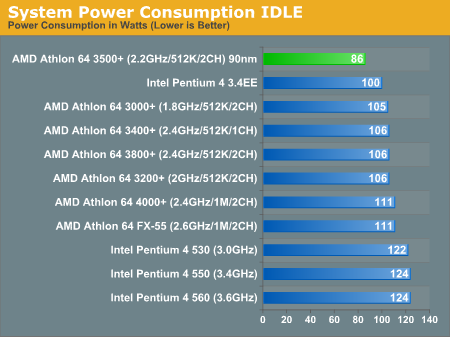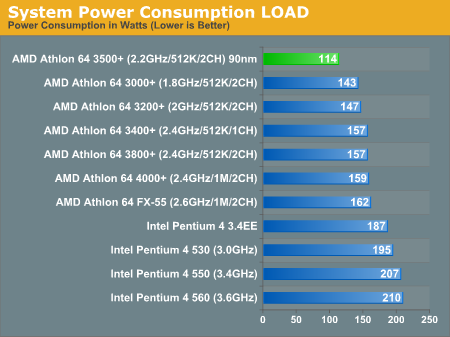AMD Athlon 64 4000+ & FX-55: A Thorough Investigation
by Anand Lal Shimpi on October 19, 2004 1:04 AM EST- Posted in
- CPUs
Power Consumption
To measure power consumption we looked at overall system power consumption and tried to keep as many variables static. There are some basic differences which we cannot get around, mainly that the 925X uses lower voltage DDR-II while the nForce4 uses regular DDR, but for the most part our results were quite controlled. We also included power consumption figures from 130nm Socket-939 Athlon 64 3200+ and 3000+ chips, which as you may know, do not exist. The reason we did this was to show the sharp contrast to the power consumption figures of the 90nm 3500+ we've included in the charts below.
We measured power consumption in two states: idle sitting at the Windows desktop and under load while running our Windows Media Encoder 9 test, which proved to be one of the most strenuous CPU tests we ran as it pretty much isolated the CPU subsystem.
At idle, the 130nm Athlon 64s all consume just about the same amount of power, with the 90nm Pentium 4s doing a little more. But what's truly impressive is the 90nm Athlon 64 3500+, drawing less power than any of the other chips at idle - by a significant margin.

Under load the situation is no different; because of the fact that AMD didn't change anything architecturally (nothing major at least) with the 90nm shrink, the Athlon 64 got what the Pentium 4 should have received with the move down to 90nm - much lower power consumption. However, tack on 32-bit ALUs (as opposed to the 16-bit ALUs in the Northwood Pentium 4), a much longer and more power hungry pipeline as well as logic to support it, and you're looking at a much more power hungry chip. The 90nm Athlon 64 does not suffer this same fate and thus is almost a lower power chip compared to the competition here.











89 Comments
View All Comments
skiboysteve - Tuesday, October 19, 2004 - link
On the Business winstone 2004..."The Pentium 4 550 and Athlon 64 3800+ tie in the middle, while the 3400+ offers statistically similar performance."
No they didnt.
microAmp - Tuesday, October 19, 2004 - link
Very nice article, loved the L2 cache and memory comparisons at the end.thermalpaste - Tuesday, October 19, 2004 - link
Way back in 2000, I felt that Intel was doing something stupid by introducing the Willamette.The thunderbird was faster than the p-III coppermine at the same clock speeds, but considering that the p-III just had 2 parallel FPUs compared to the 3 on the athlon. An additional FPU would have helped of course. though the P-III core was not able to sustain higher clock speeds , intel could have redesigned a marginally deeper pipeline on the same core rather than designing the pentium-4 with a mammoth 20 stage pipeline.
Now the prescotts come with a 30-odd stage pipeline, but the integer unit runs at twice the speed which doesn't make the 7th generation of processors from intel very 'scalable'. Besides the processor heats upto 70 odd degrees with consummate ease (Im staying in India where the avg. room temperature is something like 29 degrees Celsius) and is not overclocker friendly.
I am waiting for the newer chips from Intel, based on the Pentium-M a.k.a the P6 architecture.
AMD is way ahead of Intel as of now.
skiboysteve - Tuesday, October 19, 2004 - link
Athlon 64 4000+ - 2.4GHz - 1MB - 128-bitAthlon 64 3800+ - 2.4GHz - 512KB - 128-bit
Athlon 64 3400+ - 2.4GHz - 1MB - 64-bit
Athlon 64 3400+ - 2.4GHz - 512KB - 64-bit
Athlon 64 FX-53 - 2.4GHz - 1MB - 128-bit
these numbers look off.
Your saying there are two s754 3400+, and one has more cache?
eva2000 - Tuesday, October 19, 2004 - link
why leave out the 3700+ s754 1MB from suhc a nice comparison :)miketheidiot - Tuesday, October 19, 2004 - link
excellent article. I agree with #2 that I would have liked to see an overclocking comparison, or at least a quick demonstation of the 4000 and fx-55. Still a great article though.GhandiInstinct - Tuesday, October 19, 2004 - link
We can always marvel at them but the prices, realistcaly speaking is a waste of our time. I'm as interested in the FX-55 as much as the IBM super-computer blue.Zac42 - Tuesday, October 19, 2004 - link
I especially liked the comparrison of the equally priced value procs at the end of the article. Nice way to sum up the graphs. Good overall comparison, as you guys have just about any possible app one could use on a PC. Now we just need an OC comparrison, and we will be set!DrMrLordX - Tuesday, October 19, 2004 - link
Nice article so far, still reading it, but I would like to know where the 925XE chipset-based P4 board was in this review? Are those available to you guys yet? Just wondering.